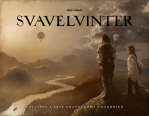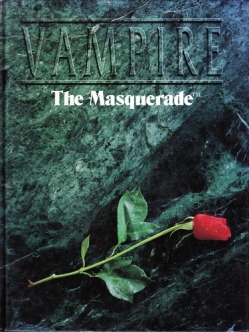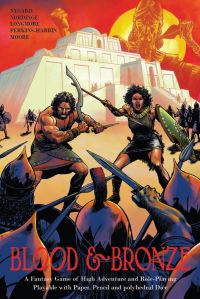Back in the 80ies, when Drakar & Demoner ruled the Swedish gaming scene, the Svavelvinter adventure took the scene by storm. Swedish gamers held it in very high regard, in a sort of a The Enemy Within kind of way. Years became decades, new but backwards incompatible versions of Drakar & Demoner were released, but Svavelvinter was still regarded as the high point in Swedish RPG history and commanded very high prices among collectors.
Recently the original author, Erik Granström, started releasing novels set in the Trakorien setting from his old adventure. And a few months ago I got the new Svavelvinter RPG in the mail. Let’s take a closer look.
The book
Svavelvinter (Eng. Sulphur Winter) is a 352 page hardcover tome in an unusual landscape format, about 22×27 cm. It is heavy, and the full colour pages fan considerably if the book is held vertically. The text is laid out in a two column format, with a very wide outside margin where sometimes an extra column of text is squeezed in. A whole group of artists have been enrolled to make the numerous illustrations throughout the book, but they have managed to keep a consistent style and feel.
(Eng. Sulphur Winter) is a 352 page hardcover tome in an unusual landscape format, about 22×27 cm. It is heavy, and the full colour pages fan considerably if the book is held vertically. The text is laid out in a two column format, with a very wide outside margin where sometimes an extra column of text is squeezed in. A whole group of artists have been enrolled to make the numerous illustrations throughout the book, but they have managed to keep a consistent style and feel.
The game is not a quick read, expect to spend many hours at even getting an overview. I wouldn’t be surprised if it would take days to read and learn ‘all of it’ before running a game.
The setting
Svavelvinter dedicates about 100 pages to describing the Trakorien archipelago and nearby lands in quite some detail, including several maps. It is a setting with a renaissance Italy feel, mixed with various bits and pieces taken from other historical periods and places, and Erik’s quirky imagination.
The rules and form
While I usually divide rules and form into separate sections I could not find a reasonable way to do so for Svavelvinter. They are intimately bound together, reinforcing each other.
Play happens at two levels, character level and shadow level. The character level play is what we usually associate with the story gaming style these days, separate but intertwining storylines about the main characters rather than a party of murder hobos travelling the land for loot and wenches. The shadow level is a boardgame played by the players, in which the powers that rule the setting compete for dominance in various areas.
Character generation is mechanically mostly limited to dividing points over the four stats; Fire, Wind, Water and Stone, and then selecting a few special abilities and the character’s goal, curse, destiny and relations. The character also has three experiences from the past, detailed with one sentence each.
Task resolution comes down to rolling pools of d6s based on the stat and a bunch of modifiers and counting 4+ results as successes, the more the better. If the roll is successful the player gains narration privileges to describe the outcome.
A single basic conflict resolution mechanism is used for everything from persuasion and pursuit to combat, albeit with a whole bunch of modifiers and special rules for every situation.
Character advancement is important. Every time one of the character’s past experiences is tagged in play to give a re-roll it is marked. When all experiences have been marked (and the character has completed an order from the shadow level of the game) the character gains a level. Levelling gives more abilities, but once the character reaches level 10 it must face it’s destiny and leave play.
The shadow level of the game is quite different, it is a board game where the players play one round at the start of every session. The events in the board game influence the character level play, giving depth and background. Every player’s PC stands under the influence of another player’s shadow power, which will give the PC orders and tasks (which when resolved enables the character to level as described above).
The game is run by a GM, but all the PCs and shadow powers are controlled by the players. The GM acts as a facilitator and arbitrator, and introduces events to colour play. Also every campaign is guided by a prophecy (8 pages of rules and tables for creating prohpecies!), the campaign ends when the prophecy has been fulfilled, at which time the players sum up their points from the shadow level board game and add their characters’ levels to find their score. This is a competitive RPG.
Conclusion
The setting is very good, lots of information and details.
The rules are excellent, they cover what the game is intended to do very well, and provide a framework for telling a very specific style of stories.
The form is excellent, the game provides great detail on how to play and run it, including an intro adventure.
Will I play it?
Yes, it seems like I will. A new group has been formed and it appears that we will rally around Svavelvinter as a common interest.
However, had I not had a group that specifically planned to play this particular game I’m not so certain. In spite of the very high grades above there are things that speak against the game.
First, it’s 350 very dense pages, without a clear flow through the text and actually learning this game is quite an undertaking when compared to the usual ~50 page games that I’ve gotten used to.
Second, the Trakorien setting is fantasy, but a very detailed and peculiar brand of fantasy. It may easily cause the same problems of mismatched expectations that occur when a group gathers to play StarWars and some players saw the original trilogy 20 years ago, and some have embraced the expanded universe stuff.
In my discussion on Fantasy! a while back I expressed fears that the game had failed to attract a following, but it seems I was wrong on that account. The initial 1000 print run had sold out, and Fria Ligan apparently has ha lively forum for the game on their own website.
—
frialigan.se/svavelvinter – The official Svavelvinter page.
sv.wikipedia.org/wiki/Svavelvinter – The Svavelvinter page on Swedish Wikipedia.
erik-granstrom.blogspot.se/ – The author Erik Granström’s blog.







